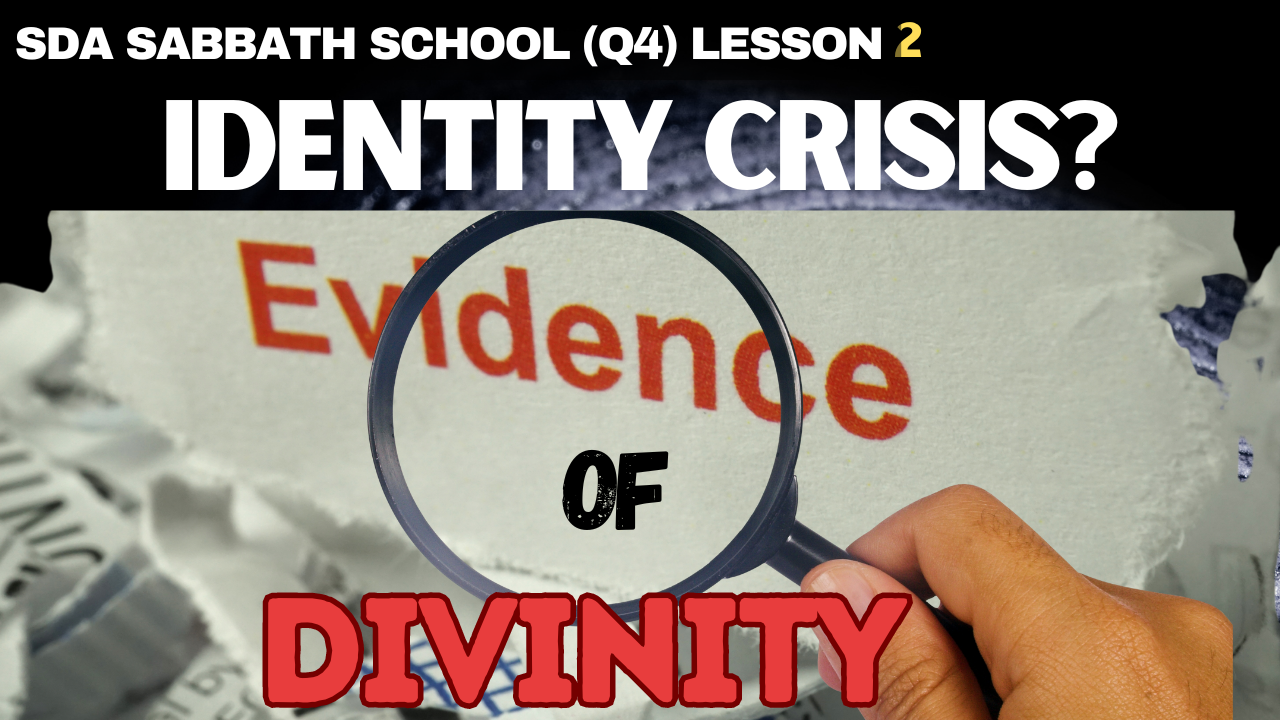The Gospel of John (Lesson 2) Signs of Divinity
IDENTITY CRISIS: EVIDENCE OF DIVINITY
Controversy over identity is nothing new. People questioned whether the former President Barack Obama was really a U.S. citizen, and still. others debate whether VP Kamala Harris is Black. But these are just shadows of a deeper, more profound question that has plagued many for centuries: Who is Jesus? The debate rages on, but this one matters for eternity. Where do you stand on who Jesus is? (Pappuse)
Welcome to our new 13-part series. Here, we’ll explore the unique message of the Gospel of John—a book unlike the other Gospels (Matthew, Mark, and Luke). John’s Gospel is different in that it gives us an up-close look at Jesus’s personal conversations with individuals who were convinced of who He is. These stories reveal deep truths about Jesus and what He means to us today. Stay with us throughout the entire series by subscribing to my YouTube Channel, Sabbath School Daily by DrBrenda Ware Davis, or going to my Website, SabbathSchoolDaily.com. This journey through John will help you get to know Jesus intimately and personally. It will help you decide, who He is and how you should relate to him.
As always, before we begin, let’s Pray. (Papuse)
Inviting God’s Presence.
Holy Father, thank you for the Gospel of John. Open our hearts and help us better understand why Jesus is so important to all of us. In Jesus’ Name, Amen! (Sp[eroi)
The Gospel of John
(Lesson 2)
Signs That Point the Way
Part 1 Introduction
Have you ever wondered who Jesus really is?
Many see Him as a great teacher or a good person, but the Bible shows that Jesus is far more than that.
He is the resurrection and the life. In other words, He is God in human form, the Creator of the universe.
Jesus helps us to understand who he is in his conversation with Martha in John 11:25 and 26
25 Jesus said to her, “I am the resurrection and the life. He who believes in Me, though he may die, he shall live.
26 And whoever lives and believes in Me shall never die. Do you believe this?” (John 11:25-26)
Jesus lived among us, but He never stopped being divine.
The Bible makes it clear that Jesus Christ is not just an ordinary man. He is the eternal Son of God.
He created life, He sustains life, and He is able to bring us back to life.
Jesus has always existed—before anything was ever made. He is not a created being.
Although it may be difficult for our human minds to understand, Jesus has always existed. John 1:1-3 tells us
1 In the beginning was the Word, and the Word was with God, and the Word was God.
2 He was in the beginning with God.
3 All things were made through Him, and without Him nothing was made that was made. (John 1:1-3)
This verse shows us that Jesus wasn’t created; He is the Creator. Everything we see, and even things we can’t see, came from Him. Jesus has always lived.
When Jesus came to earth, He took on a human body. But even though He became human, He was still God.
He never stopped being God. Throughout His life, He showed us many times that He was divine, not just through His words but also through His actions.
One of the best ways to see Jesus’ divinity is through the miracles He performed. Pause
John calls his miracles signs. Signs of what? Signs of who Jesus is. The Book of John discusses some of the greatest signs that showed who Jesus truly is.
These signs were more than just wonders; they were messages to the people around Him that He is God.
However, not everyone understood the message. Some people rejected Jesus, others plotted to kill Him, and yet, some believed.
Even though these miracles clearly showed Jesus’ divinity, not everyone believed.
Some people’s hearts were hardened. They couldn’t or wouldn’t accept the truth that was right in front of them.
However, for those who did believe, these signs were life changing.
They realized that Jesus wasn’t just a man—He was the Son of God, the Messiah, the Anointed One.
What about you? Who is Jesus to you? He has the power to change the impossible, to bring life where there is death, and to open our eyes to the truth.
Jesus is not just a figure from the past. He’s alive today, and He offers that same power and love to all of us. No one else can take Jesus’ place.
One sure evidence of Jesus’ divinity was when he was in the company of 5000 Hungry people. What did he do? Did he leave them hungry? Read John 6:1-14
Then continue to Part 2: The Feeding of the Five Thousand.
The Gospel of John
(Lesson 2)
Signs That Point the Way
Part 2: Feeding of the Five Thousand
You are in a crowd of thousands, and you’re hungry. There’s no food in sight, but one man takes a small boy’s lunch, just five loaves of bread and two fish, and feeds everyone.
This man is Jesus, and this sign wasn’t just about food. It was about showing who Jesus really is.
He is the one who can provide for us in ways beyond what we can think or imagine.
How do His miracles connect to an even bigger picture? They show God’s plan to deliver us through His son Jesus and they show His love for us.
Jesus feeding more than 5,000 people with just a small amount of food: five loaves of bread and two fish is significant because it is at a very special time; it is near the time of the Passover.
The Passover was a commemoration of how God delivered Israel from Egyptian slavery.
You might recall that during the Passover, a lamb was killed, and its blood was put on the doors of the Israelites so the angel of death would pass over their homes.
The Passover lamb took the place of the death of the firstborn. This lamb symbolized Jesus, who would one day die for our sins, taking our place so we could be saved.
On the cross, Jesus received the punishment we should receive for our sins.
Paul, in 1 Corinthians 5:7, points out that “Christ, our Passover, was sacrificed for us.” (1 Corinthians 5:7)
Thus, when Jesus died on the cross, He took on the punishment we deserved for our sins.
“He bore the guilt of transgression, and the hiding of His Father’s face, until His heart was broken and His life crushed out. All this sacrifice was made that sinners might be redeemed.”—Ellen G. White, The Great Controversy, p. 540.
This was a powerful act of love, and Jesus’ death made it all possible for us to have eternal life.
Now, let’s look back at the story in John 6:1-14. Where Jesus fed the 5000.
Jesus saw a large crowd of people who were hungry, and He asked His disciple, Philip, where they could buy enough food for everyone. Philip didn’t know what to do—there were so many people, and they didn’t have enough money or food.
But Jesus already had a plan. So, Andrew, Simon Peter’s brother tells Jesus a young boy has a small lunch of five loaves and two fish.
Jesus took that little bit of food, gave thanks, and began to distribute it.
Miraculously, it became enough to feed everyone—more than 5,000 people! After everyone had eaten, the disciples gathered up the leftovers and filled 12 baskets.
This miracle was more than just feeding people.
To the Jews, it was a reminder of something from their past: the time when Moses led their ancestors out of slavery in Egypt.
After they escaped, the Israelites were in the desert and had no food.
But God provided for them by sending manna—bread from heaven.
Just like Moses, Jesus provided food for the people, but this time, it was even more miraculous.
The bread Jesus gave didn’t just fill their stomachs; it pointed to the fact that Jesus Himself is the “bread of life”—the One who satisfies our deepest needs.
Numerous details of the miracle of Jesus feeding to 5000 parallel with Israel’s deliverance from Egypt.
- Jesus went up on a mountain (John 6:3) Moses also went up a mountain, Mount Sinai, when he received the Ten Commandments from God.
- Jesus tested Philip (John 6:5-6). In the desert, the Israelites were tested by God to see if they would trust Him to provide food and water.
- Jesus fed over 5,000 people with five loaves of bread and two fish. This was a clear reminder of how God provided manna for the Israelites in the desert during their journey to the Promised Land.
- The disciples collected 12 baskets of leftovers (John 6:12). This number is significant because there were 12 tribes, or family groups, of Israel. It’s as if Jesus was saying, “I am here for all of God’s people.”
After seeing this miracle, the people said, in John 6:14
“This is truly the Prophet who is to come into the world.” (John 6:14).
They were referring to the special messenger Moses had promised would come in Deuteronomy 18:15.
15 “The Lord your God will raise up for you a Prophet like me from your midst, from your brethren. Him you shall hear, (Deuteronomy 18:15)
This Prophet was Jesus, the One who came not just to feed people but to free us from sin.
Through this miracle, Jesus was showing the people that He was like Moses, but He was also much more.
Jesus didn’t just come to lead them out of physical slavery; He came to lead them out of spiritual slavery—to free them from sin and death.
John, therefore, shows that miracles weren’t just signs and wonders. They were signs pointing to someone greater—who He is and what He came to do.
The question is: Will we accept what Jesus is offering? Will we trust Him to provide for us, not just with the things we need today, but with the eternal life He offers?
Jesus gave His life so we could be free.
Isaiah 53:4–6 and 1 Peter 2:24 teach that Jesus, as the Lamb of God, bore sins and suffering in our place.
His divinity makes His sacrifice sufficient for all. God offers us salvation through Jesus’ atoning death as a manifestation of His love for humanity.
How did the people respond to His miracle? How did Jesus use these signs to try to teach the people who He is? Read John 6:14, 15, 26–36.
Then, View the next segment of this video, Part 3: “Surely, He is the Prophet.”
The Gospel of John
(Lesson 2)
Signs That Point the Way
Part 3: “Surely He is the Prophet”
Sometimes, we get caught up in the things we want and miss what we truly need.
In Jesus’ time, many people were focused on earthly desires—freedom from oppression, wealth, and power.
But Jesus came to offer something much greater: eternal life.
In John 6:14-15 and 26-36, we see that after Jesus fed more than 5,000 people with just five loaves of bread and two fish, the crowd was amazed.
Two of the most challenging things to manage in war are feeding the troops and caring for the wounded and dead.
By His miracles, Jesus showed that He could do both.
John 6:14 says the people responded by saying,
“This is truly the Prophet who is to come into the world.” (John 6:14)
They thought Jesus was the one who would save them from the Romans and restore Israel to power.
In fact, they were so convinced that they wanted to make Him their king right then and there.
But Jesus didn’t come to lead a political revolution. He had a much bigger mission.
In verses 26-36, Jesus tries to correct their misunderstanding. He tells them that they are following Him not because they truly believe in who He is but because they want more free food.
Jesus says in verse 27,
27 Do not labor for the food which perishes, but for the food which endures to everlasting life, which the Son of Man will give you, because God the Father has set His seal on Him.” (John 6:27)
He was offering them something far greater than bread that satisfies for a moment—He was offering them eternal life, something that lasts forever.
Therefore Jesus goes on to explain in verse
35, “I am the bread of life. He who comes to Me shall never hunger, and he who believes in Me shall never thirst.” (John 6:35)
This is a powerful statement. Jesus was saying that just as physical bread satisfies hunger, He satisfies the deep spiritual hunger in our hearts.
We all have a need for purpose, love, and meaning, and only Jesus can fill that need.
This is the first of seven “I am” statements that Jesus makes in the book of John.
In these statements, Jesus is telling us who He is. Each one is connected to something important about Jesus’ identity and mission:
“I am the bread of life” (John 6:35)
“I am the light of the world” (John 8:12)
“I am the door” (John 10:7, 9)
“I am the good shepherd” (John 10:11, 14)
“I am the resurrection and the life” (John 11:25)
“I am the way, the truth, and the life” (John 14:6)
“I am the true vine” (John 15:1, 5)
Each statement points to an important truth about Jesus and who He is.
The phrase “I AM” takes us back to Exodus 3, when God presents Himself to Moses as the great I AM. God, in Exodus 3:14, tells Moses, “I AM WHO I AM.”
By using the phrase I Am, Jesus was telling the people that He was God Himself, the same God who had led their ancestors out of Egyptian slavery.
Jesus made this same statement in John 8:58.
58 Jesus said to them, “Most assuredly, I say to you, before Abraham was, I AM.”
But the crowd missed this point. They were looking for something else.
They wanted Jesus to be a king who would free them from Roman rule, give them wealth, and make them powerful.
They didn’t understand why, if Jesus could perform such amazing miracles, He didn’t use His power to make them healthy, wealthy, and free.
Ellen White, in the Book Desire of Ages, writes: Their dissatisfied hearts asked why, if Jesus could perform so many wondrous works as they had witnessed, could He not give health, strength, and riches to all His people, free them from their oppressors, and exalt them to power and honor?
The fact that He claimed to be the Sent of God, and yet refused to be Israel’s king, was a mystery which they could not understand. His refusal was misinterpreted. Many concluded that He dared not assert His claims because He Himself doubted as to the divine character of His mission. Thus they opened their hearts to unbelief, and the seed which Satan had sown produced fruit of its kind, in misunderstanding and desertion.”—Ellen G. White, The Desire of Ages, p. 385.
Instead of seeing Jesus as the Savior who came to offer eternal life, they saw Him as someone who could solve their temporary, earthly problems.
This happens to us too. It’s easy to get caught up in wanting God to fix things in our lives—our finances, our health, our jobs—and forget what He’s really offering.
Jesus didn’t come just to make our lives easier on earth. He came to save us from sin and death.
And while He does care about our everyday needs, He wants us to focus on what truly matters—our spiritual lives and our relationship with Him.
The people in Jesus’ time missed the bigger picture because they were focused on the here and now.
We face the same temptation. Are we looking for God just to fix our problems, or are we seeking Him because He is the Bread of Life, the One who can satisfy our deepest needs? (Pause)
Jesus continues shows evidence of who He is. He heals a blind man. Like many of us today, the disciples had a misconception about the man’s disability.
What did Jesus’ disciples believe about the man, and how did Jesus correct their misconception? Read John 9:1-16
Then, Continue to the next segment of this video, Part 4: The Healing of the Blind Man Part 1
The Gospel of John
(Lesson 2)
Signs of Divinity
Part 4: Healing of the Blind Man Part 1
Have you ever wondered why bad things happen to seemingly good people? In Jesus’ time, many believed that suffering or sickness was always the result of sin.
But Jesus came to show us a new way of understanding suffering and how God can work through it for a greater purpose.
In John 9:1-16, we meet a man who was born blind.
As Jesus and His disciples walked by, the disciples, in John 9:2, asked
“Rabbi, who sinned, this man or his parents, that he was born blind?” (John 9:2).
The disciples, like many people at the time, believed that if someone was sick or had a disability, it was because they or their family had done something wrong. (Pause)
This belief came from many Old Testament stories where sin and punishment seemed to be related.
This we see in Exodus 20:5,
2 Kings 5:15–27,
2 Kings 15:5,
2 Chronicles 26:16–21.
For example, in Exodus 20:5, God says He would visit the sins of the parents upon their children to the third and fourth generations.
This made people think that if a child was born with a condition, it must be because of the parent’s sins.
However, when we read Job’s story, we see a different story. We learn that not all hardships, infirmities, or calamities are the results of wrongdoing.
For instance, Job was sorely afflicted, and his friends sought to make him acknowledge that his suffering was the result of sin, and cause him to feel under condemnation. They represented his case as that of a great sinner; but the Lord rebuked them for their judgment of His faithful servant.
There is wickedness in our world, but all the suffering is not the result of a perverted course of life. (The Seventh-day Adventist Bible Commentary, vol. 3, p. 1140)
This is the point Jesus is making in John 9:3, in response to his disciples,
3 Jesus answered, “Neither this man nor his parents sinned, but that the works of God should be revealed in him. (John 9:3)
Now, Jesus wasn’t denying that sin can lead to suffering. Sometimes, our bad choices do bring painful consequences.
But Jesus was making the point that not all suffering is a direct result of sin.
In this case, the man’s blindness had a higher purpose. It was an opportunity for God to be glorified by showing His power to heal.
This man’s infirmity wasn’t about blame—it was about God using this situation to show His love and healing power.
Then, Jesus did something very interesting. He spit on the ground, made some mud with the dirt, and put it on the man’s eyes.
He told the man to wash in the Pool of Siloam, and when he did, he came back and could see!
This act of healing takes us back to the Creation Story in Genesis 2:7, where God made the first man from the dust of the ground.
7 And the Lord God formed man of the dust of the ground, and breathed into his nostrils the breath of life; and man became a living being. (Genesis 2:7)
Just like God created life from the dust, Jesus gave this man new life—a new sight—using the same dirt.
Jesus gave this blind man what was missing from the womb: his sight.
In the Gospels of Matthew, Mark, and Luke, stories of miracles often follow a pattern:
- There’s a problem (someone is sick or in need of healing).
- The person comes to Jesus for help.
- Jesus heals them.
- The person praises God, and others praise God too.
This story in John 9 follows this same pattern, but John gives us something more.
The miracle itself is important, but the conversation afterward reveals the deeper meaning behind it.
We are brought into a long interaction between the healed man and the religious leaders.
The man who was healed now had a new challenge: dealing with the religious leaders who didn’t believe his healing was from God.
The Pharisees, the religious leaders of the time, had strict rules about the Sabbath.
They believed no one should do any work on that day, and healing someone was considered “work.”
Two intertwined contrasting pairs of concepts are seen here; there is the contrast between:
- Sin vs. the Works of God
- Blindness vs. Sight
Although John tells us about Jesus healing the blind man, he does not tell us that this healing occurred on the Sabbath until John 9:14.
According to traditions, not Scripture, healing violated the Sabbath. It was considered work. Therefore, because Jesus healed on the Sabbath, the Pharisees considered Him a Sabbath-breaker.
Thus, they concluded that Jesus must not be from God.
So, when they found out that Jesus healed the blind man on the Sabbath, they were angry. John 9:16 says:
16 Therefore some of the Pharisees said, “This Man is not from God, because He does not keep the Sabbath.” Others said, “How can a man who is a sinner do such signs?” And there was a division among them. (John 9:16).
The healed man, now able to see physically, also began to see spiritually who Jesus truly is.
However, the religious leaders, even though they could see with their eyes, were spiritually blind. They refused to accept that Jesus could be from God because He didn’t follow their traditions exactly the way they thought He should. (Pause)
Notice what it says here:
Not infrequently, the minds of even God’s servants are so blinded by tradition and false teaching that they only partially grasp the things revealed in His Word. (From Here to Forever, pp. 215, 217.)
There is a danger in being so blinded by our own beliefs, traditions, and misconceptions. We can miss important truths right before our own eyes.
The healed man testified that Jesus had performed a miracle in his life, but the Pharisees didn’t want to believe it.
They were so focused on their rules that they couldn’t recognize God’s work right before them.
While the man who was blind, now he has both his physical and spiritual sight.
On the other hand, the religious leaders remained blind in their hearts, unable to see the truth about Jesus.
This story is a reminder that not all suffering is caused by something we have done wrong.
Sometimes, God allows difficulties in our lives to reveal His power and show His love to us.
It also challenges us to see beyond our traditions and mindsets and recognize how God is working in unexpected ways in our lives.
You might expect the story of the blind man to end here, with him going on to experience the world through his newly gained sight.
But it does not; the religious leaders would not let up. What did they do next? Read John 9:17-34 for the rest of the story.
Then, continue to the next segment of this video: Part 5: The Healing of the Blind Man: Part 2
The Gospel of John
(Lesson 2)
Signs of Divinity
Part 5: Healing of the Blind Man Part 2
Some people just refuse to believe the truth, even when it’s right in front of them. This happened in the story of the blind man Jesus healed.
The religious leaders didn’t want to accept that Jesus was the one sent from God, even though the evidence was clear.
After Jesus healed the blind man, the Jewish religious leaders—known as the Pharisees—were furious.
This man had been blind for his whole life, and then suddenly, he was able to see.
But instead of celebrating, the religious leaders refused to believe it was a miracle.
So, in John 9:17-34, we see that the Jewish leaders are upset. They didn’t want to believe that Jesus had performed this miracle, especially because He did it on the Sabbath, a day they believed no one should work, not even to heal someone.
So, they called the man in for questioning.
They asked him in John 9:17, “What do you say about Him because He opened your eyes?” (John 9:17).
The man replied, “He is a prophet.”
At this point, the man didn’t fully know who Jesus was, but he could tell that Jesus was from God. (Papuspe)
This wasn’t what the leaders wanted to hear. So, they called the man’s parents to ask if he was truly born blind in John 9:17-21
19 And they asked them, saying, “Is this your son, who you say was born blind? How then does he now see?”
20 His parents answered them and said, “We know that this is our son, and that he was born blind;
21 but by what means he now sees we do not know, or who opened his eyes we do not know. He is of age; ask him. He will speak for himself.” (John 9:17-21)
His parents confirmed who he was and that he had gained his sight but were too scared to say much else because they didn’t want to get in trouble with the leaders.
Still not satisfied, the leaders called the man back John 9:24
24 So they again called the man who was blind, and said to him, “Give God the glory! We know that this Man is a sinner.” (John 9:24).
But the man boldly responded verse 25
25 He answered and said, “Whether He is a sinner or not I do not know. One thing I know: that though I was blind, now I see.” (John 9:25).
This was a simple yet powerful truth. The man wasn’t a theologian or a scholar, but he knew the change that had happened to him.
He was blind, and now he could see, thanks to Jesus.
The leaders kept pressing him, asking him again how Jesus had healed him. But the man had had enough. John 9:27 says
27 He answered them, “I told you already, and you did not listen. Why do you want to hear it again? Do you also want to become His disciples?” (John 9:27).
This made the Jewish leaders furious. In response, they sought to insult him, saying in John 9:28,
“You are His disciple, but we are Moses’ disciples. (John 9:28).
The Pharisees believe Jesus is a sinner because He healed someone on the Sabbath (John 9:16, 24),
They believed that because they followed the laws of Moses, they didn’t need to have anything to do with this Jesus.
The man, now seeing more clearly, both physically and spiritually, points out in verse 32, “Since the world began it has been unheard of that anyone opened the eyes of one who was born blind (John 9:32)
Then in John 9:33 He said,
33 If this Man were not from God, He could do nothing.” (John 9:33).
This truth was too much for the religious leaders. Instead of accepting it, they insulted the man again, saying,
“You were born in sin!” and threw him out (John 9:34).
What’s amazing about this story is how it reverses everything. The man who was physically blind now sees who Jesus really is. He understands that Jesus must be from God.
But the religious leaders, who should have had spiritual insight, were spiritually blind. They refused to see the truth about Jesus.
John uses this story to show us that Jesus is more than a miracle worker—He is “the Light of the world” (John 9:5).
Jesus didn’t just give the man physical sight; He brought spiritual light into the world.
This story asks a deeper question: Who is Jesus? Where did He come from? What did He come to do?
The religious leaders, blinded by their own rules and pride, couldn’t answer these questions.
But the man who had been healed knew that Jesus had come from God.
John 9 also reminds us that some people, like the religious leaders, love their sin more than the truth.
They don’t want to accept Jesus, even when the evidence is clear.
But others, like the blind man, accept Jesus in faith and experience the transformation that only He can bring.
This story serves as a warning. The Jewish leaders had all the proof they needed to believe in Jesus, but their hearts were hard.
They didn’t want to know the truth. This is a reminder to us that if we close our hearts, we can miss the truth about who Jesus is.
The Bible warns us in 1 Corinthians 1:26-29 that God often chooses the humble and weak to reveal His truth.
The blind man didn’t have status or power, but he saw Jesus for who He really is.
The religious leaders, on the other hand, were too proud to admit they were wrong. Let’s not let pride blind us from the truth.
Instead, let’s keep our hearts open to what God is trying to show us through Jesus, the Light of the world.
Still seeking to help us understand who Jesus is and give us evidence of his divinity, John shares another incredible story. Who then could deny that Jesus is Divine? Read John 11
Then, continue to the next segment of this video, Part 6: The Resurrection of Lazarus.
The Gospel of John
(Lesson 2)
Signs of Divinity
Part 6: The Resurrection of Lazarus
Life can sometimes be full of sad moments, and in John 11, we find a story filled with grief and loss. But this story doesn’t end in sadness.
It reveals something extraordinary about Jesus and the power He has, not just over sickness but even over death.
In John 11, we learn that Lazarus, a close friend of Jesus, was very sick.
John 11:1-3
1 Now a certain man was sick, Lazarus of Bethany, the town of Mary and her sister Martha.
2 It was that Mary who anointed the Lord with fragrant oil and wiped His feet with her hair, whose brother Lazarus was sick.
3 Therefore the sisters sent to Him, saying, “Lord, behold, he whom You love is sick.” (John 11:1-3)
His sisters, Mary and Martha, sent word to Jesus, hoping that He would come and heal their brother.
But instead of rushing to help, Jesus did something unexpected—He waited two more days before going to see them
John 11:6
6 So, when He heard that he was sick, He stayed two more days in the place where He was. (John 11:6).
This must have been confusing and heartbreaking for the sisters because they knew Jesus had the power to heal. When Jesus finally arrived, Lazarus had already been dead for four days
John 11:17
17 So when Jesus came, He found that he had already been in the tomb four days. (John 11:17).
Mary and Martha were grieving, and they both expressed their disappointment to Jesus. Martha said, John 11:21
“Lord, if you had been here, my brother would not have died” (John 11:21).
Mary echoed the same words in verse 32. They couldn’t understand why Jesus hadn’t come sooner to save their brother. It seemed like it was too late for a miracle.
But Jesus had a bigger plan in mind. He explained to His disciples that He was actually glad He hadn’t gone earlier, saying in John 11:14-15,
14 Then Jesus said to them plainly, “Lazarus is dead.
15 And I am glad for your sakes that I was not there, that you may believe. Nevertheless let us go to him.” (John 11:14-15)
Jesus wasn’t being heartless. He deeply cared for Lazarus and his sisters, but He knew that by waiting, He would have the chance to show God’s power in a way that would leave no doubt about who He really is.
When Jesus arrived at the tomb, Martha was still anxious, telling Him,
“ ‘Lord, by this time there is a stench, for he has been dead four days’ ” (John 11:39).
By waiting until the fourth day, Jesus was about to perform an even greater miracle than just healing a sick person or giving sight to a blind person; He was going to raise a man whose body had already begun to decay.
This wasn’t just about restoring life but proving that Jesus had power over death itself.
What more proof could Jesus have given that He was indeed God Himself?
Before calling Lazarus from the grave, Jesus made a powerful statement in John 11:25-26: He says:
“I am the resurrection and the life. He who believes in Me, though he may die, he shall live.
26 And whoever lives and believes in Me shall never die. Do you believe this?” (John 11:25-26)
This was a bold declaration. Jesus wasn’t just saying He could bring people back to life—He was saying that He is life itself.
As God, Jesus has control over life and death.
Then, in John 11:38-44, Jesus approached the tomb. He prayed to God and then called out in a loud voice,
“Lazarus, come out!”
To everyone’s amazement, Lazarus walked out of the tomb, alive and well.
Jesus had raised a man from the dead!
This miracle was undeniable proof that Jesus was more than a prophet or teacher—He was God Himself, with the power to give life.
This miracle also supported something Jesus had said earlier about Himself:
He is the “Light of the world” (John 8:12; John 9:5).
Just as He gave physical sight to the blind man in John 9, He now demonstrated that He is the “Resurrection and the Life” by raising Lazarus from the dead.
This miracle, more than any other, showed the Jewish leaders—and everyone else—that Jesus is the God who gives life.
It confirmed what John had been writing about all along:
Jesus is the Son of God, and when we believe in Him, we receive everlasting life through Him (John 20:30-31).
Sadly, not everyone was happy about this miracle. Instead of celebrating, the religious leaders felt threatened by Jesus’ growing influence.
Despite witnessing His power over death, they still plotted to kill Him, thinking that by doing so, they could stop Him, according to John 11:45-54.
It’s strange, isn’t it? Such sad irony, Jesus had just proven that He could raise the dead, yet the leaders believed they could stop Him by killing Him.
They couldn’t see the truth, even when it was right in front of them.
The story of Lazarus reminds us that Jesus has power over life and death. He is the God who gives us life, not just in this world but eternally. When we face sadness, grief, or loss, we can remember that Jesus is always in control.
Even when things seem hopeless, Jesus can turn the situation around in ways we never imagined.
The question is: Do we believe in Jesus as the “Resurrection and the Life”?
Just as He raised Lazarus, He can bring new life into our situations. Trust Him today to be the God who gives you life.
———————————————–
Thank you for watching this video.
To be notified when my next video is released, Subscribe to my YouTube Channel, SabbathSchoolDaily by Dr. Brenda Ware Davis.
You may watch many of my other videos @ SabbathSchooldaily.com
You may obtain a free study guide for this series at Sabbath.School or ssnet.org
If you enjoyed this video, click Like…..Then…..Share.
Thank you for Liking, Sharing, and Subscribing.
Hebron Seventh-day Adventist Church
7902 Wheatly Street
Houston, TX 77088
hebrontx.adventistchurch.org
Watch Past and Present Lessons at SabbathSchoolDaily.com














Post Comment